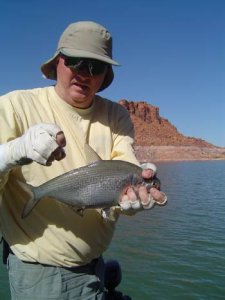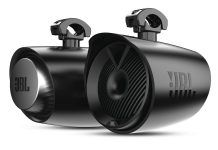
STILL TIME — Dan Austin caught a gizzard shad while casting 3-inch plastic single-tailed grubs in Lake Powell’s Ticaboo Canyon. Fishing continues to be incredibly good despite full moon, rising water, runoff stain, rapid warming, and many other variables that tend to slow things down. It hasn’t happened yet. There is still time for an excellent spring fishing trip.
Good fishing continues as hungry sport fish compete for limited forage. Last year’s forage is at the low point for the year and newly spawned fish are not yet large enough to provide food for adult fish. The result is fast fishing for stripers, walleye, and smallmouth bass.
Stripers continue to travel the deep canyon walls from Glen Canyon Dam to Bullfrog and all spots in between. They are readily caught on anchovy bait fished at 30-50 feet near the wall and on cliff points and talus rock piles.
Chum to get the school started and then harvest all fish caught as the population is overabundant and must be downsized to keep the fisheries healthy. Some of the hotspots include Navajo, Last Chance, Oak and Reflection, Jacks Arch, Escalante, Moki, Hansen Creek and Red Canyon.
In The Mood For Bigger Food
There are fewer 4- and 5-pound stripers being caught each day, but it is difficult to tell because juvenile striped bass have begun feeding on plankton in very large schools in 10-20 feet of water.
Theses stripers prefer a larger food item, so a cast or trolled lure gets whacked a number of times as it traverses the large school.
Juvenile stripers are in prime condition and provide a better meal than the thin 4-pound fish. When a school of juveniles is located, they can be caught quickly on small lures such as white grubs, small spoons (Kastmaster or Wally lure) or small crankbaits.
Stationary schools of juveniles are located in Wahweap Bay (Castle Rock Cut), Navajo Canyon (points behind the double islands), and Padre Bay (buoy 21A). Find the schools by shallow, slow trolling a spoon or jig with small grub attached.
When a fish is caught, immediately cast ½ ounce spoons in the area (much like fishing boils) to keep the school active while the first fish is landed.(I took 15 stripers in 15 consecutive casts using this method in Wahweap Bay.)
Hungry stripers too big to eat plankton are searching for crayfish on all rocky shoreline near deep water. Fishing a plastic tube or grub on the edges of the main channel is a sure thing for stripers and walleye.
There’s Still Time
Stripers are readily caught trolling the edge of the channel with deep-diving crank baits. Walleye are caught using the same trolling methods near shore where a bit of mud is stirred up by wind or boat wakes.
Use Hot-n-Tot and Wally Divers to target walleye or deep Thundersticks or Deep Husky Jerks to target stripers. When a fish is caught trolling, it’s a good idea to cast plastic tubes and grubs to see if a school of stripers or group of walleye is in the vicinity.
If this isn’t enough, then smallmouth bass are hot on most vertical rocky structure. Bounce a tube or grub along bottom or drag them from reef to reef to catch bass up to 3 pounds.
Fishing continues to be incredibly good despite full moon, rising water, runoff stain, rapid warming and many other variables that tend to slow things down. It hasn’t happened yet. There is still time for an excellent spring fishing trip.
At press time, lake elevation was 3,597, and water temperature was 68-75 F.































